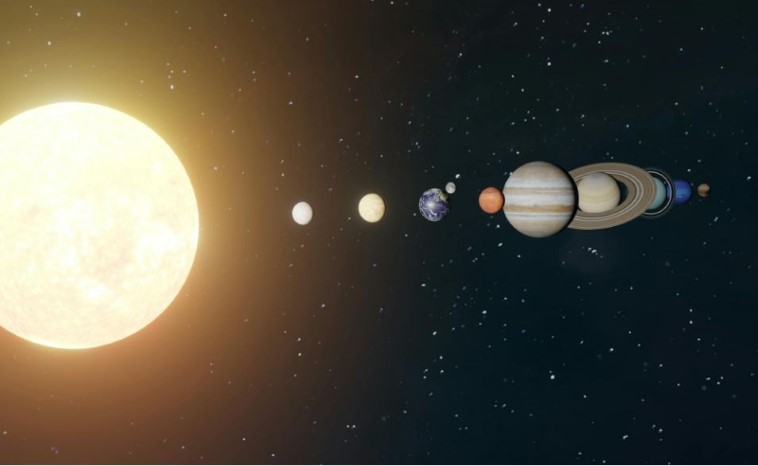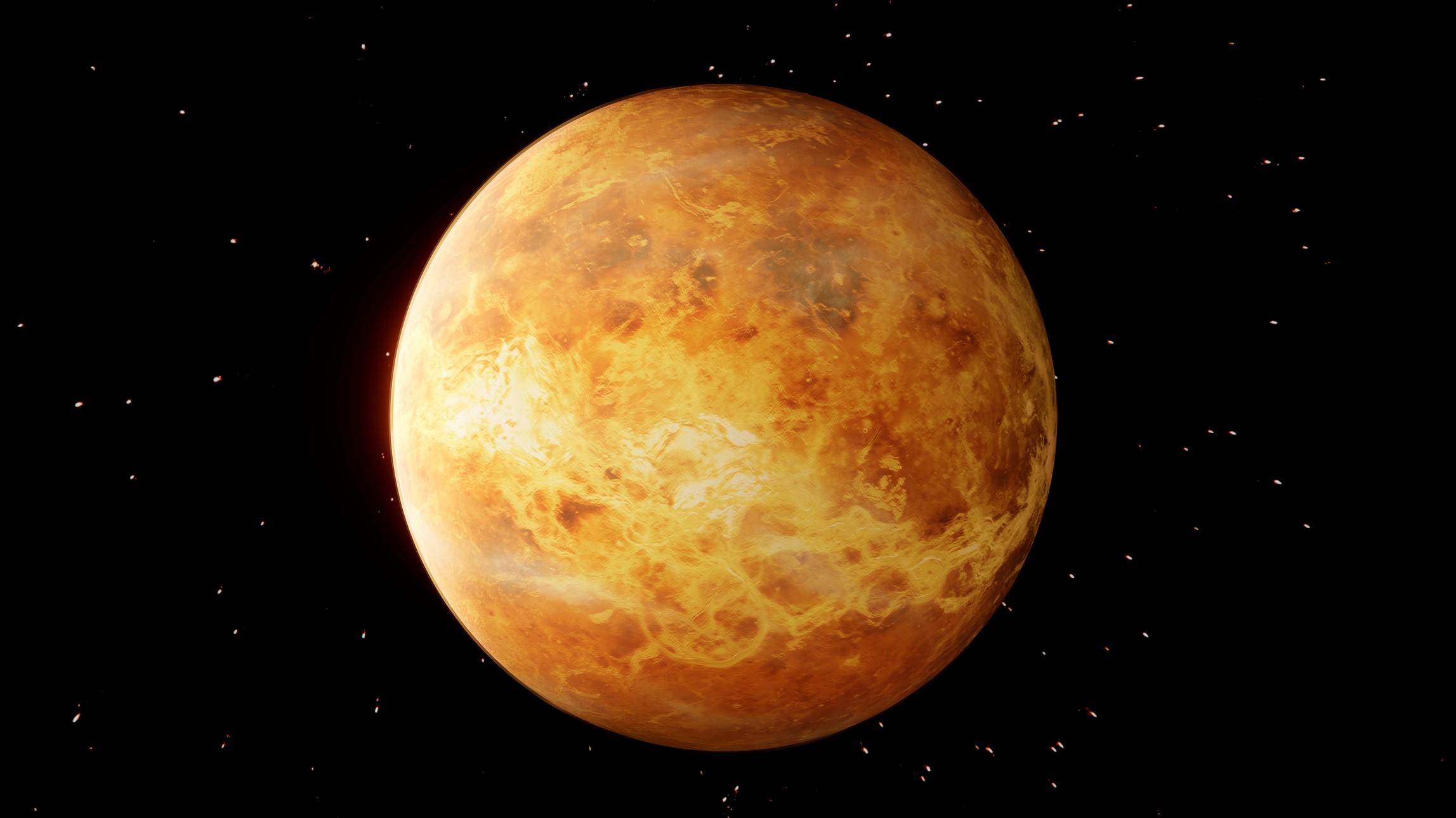When you think of the hottest planet in our solar system, you might naturally assume it’s Mercury, the one closest to the Sun.
But surprisingly, that’s not true — the title of hottest planet belongs to Venus.
Even though Venus is nearly twice as far from the Sun as Mercury, its surface is scorching hot — with temperatures hot enough to melt lead.
So why is Venus hotter than Mercury?
At Spaceyv, we’ll break down the science behind this cosmic mystery — exploring Venus’s atmosphere, greenhouse effect, rotation, and albedo — and how they combine to make it an infernal world unlike any other.
🌍 Quick Answer: Why Is Venus Hotter Than Mercury?
Here’s the simple explanation:
Venus is hotter than Mercury because of its thick carbon dioxide atmosphere, which traps heat through an extreme greenhouse effect.
Mercury, on the other hand, has almost no atmosphere to retain heat.
So while Mercury’s days are blazing hot, its nights are freezing cold — Venus stays consistently hot all the time.
Now, let’s dive deep into the science behind the heat.

🌞 1. The Basic Facts: Venus vs. Mercury
Before understanding why Venus is hotter, it helps to compare the two planets side by side.
| Feature | Mercury | Venus |
|---|---|---|
| Distance from Sun | ~57.9 million km (0.39 AU) | ~108.2 million km (0.72 AU) |
| Atmosphere | Almost none (thin exosphere) | Very thick (96% carbon dioxide) |
| Surface Temperature (avg) | Day: 430°C / Night: -180°C | Constant: ~465°C |
| Surface Pressure | 0 (vacuum) | 92 times Earth’s (like being 1 km underwater) |
| Rotation Period | 59 Earth days | 243 Earth days (retrograde) |
| Albedo (reflectivity) | 0.12 (absorbs most sunlight) | 0.75 (reflects most sunlight) |
At first glance, Mercury should logically be hotter — it’s closer to the Sun and absorbs more solar radiation per square meter.
Yet, Venus wins the heat battle every time — because of what’s happening in its atmosphere.
🌫️ 2. Venus’s Atmosphere: The Real Culprit
Venus has an incredibly dense and thick atmosphere, composed mostly of carbon dioxide (CO₂) — the same gas that traps heat on Earth, but in extreme abundance.
Here’s what makes Venus’s atmosphere so deadly:
-
Composition: ~96.5% carbon dioxide, 3.5% nitrogen, trace sulfur dioxide
-
Thickness: About 90 times denser than Earth’s atmosphere
-
Pressure: Equivalent to being nearly 1 kilometer underwater
This enormous blanket of CO₂ acts like an insulating shell, trapping heat from the Sun and preventing it from escaping back into space.
The result?
A runaway greenhouse effect — far stronger than anything seen on Earth.
🔥 3. The Greenhouse Effect Explained (Venus Edition)
To understand Venus’s extreme heat, we need to look at the greenhouse effect, a process that happens on every planet with an atmosphere — including Earth.
Here’s how it works:
-
Sunlight (visible light) passes through a planet’s atmosphere and reaches the surface.
-
The surface absorbs this energy and re-emits it as infrared radiation (heat).
-
Greenhouse gases (like CO₂, water vapor, methane) absorb and trap some of this infrared radiation.
-
This trapped heat warms the planet’s lower atmosphere and surface.
On Earth, this effect keeps temperatures livable (~15°C on average).
On Venus, it’s catastrophic.
Because Venus’s atmosphere is almost entirely carbon dioxide and is dozens of kilometers thick, it traps heat extremely efficiently.
Once sunlight penetrates the upper clouds, it gets absorbed by the surface and bounces between the surface and clouds — endlessly reheating the lower layers.
That’s why Venus’s surface temperature stays at 465°C (869°F) day or night, equator or pole — a uniform, furnace-like world.
🌡️ 4. Mercury’s Problem: No Atmosphere, No Insulation
Mercury is closer to the Sun, so it receives about 7 times more solar energy than Venus.
But here’s the catch: it has almost no atmosphere to hold the heat.
Mercury’s “atmosphere” — called an exosphere — is just a thin layer of scattered particles from solar wind and micrometeorite impacts.
Because of this, heat escapes into space instantly once the Sun sets.
That’s why:
-
Mercury’s daytime temperatures reach about 430°C (800°F).
-
But at night, they plummet to -180°C (-290°F).
So while Mercury is hot during the day, it’s the coldest of all inner planets at night — the exact opposite of Venus’s hellish consistency.
☁️ 5. The Role of Venus’s Cloud Layers
Venus’s sky is permanently covered in thick, yellowish clouds made of sulfuric acid droplets.
These clouds sit 50–70 km above the surface and reflect about 75% of sunlight back into space — giving Venus a bright, shiny appearance in the night sky.
This may sound like it should cool Venus down, but ironically, the clouds trap heat beneath them.
The sunlight that does penetrate the upper layers gets absorbed by the lower atmosphere and surface, and can’t escape back through the dense cloud layers.
So Venus’s clouds create a “heat trap”, reinforcing the already extreme greenhouse effect — like wrapping the planet in multiple thermal blankets.

🌀 6. Venus’s Slow and Backward Rotation
Venus rotates extremely slowly — it takes 243 Earth days to complete one rotation.
That’s longer than its 225-day year (the time it takes to orbit the Sun)!
Even more interesting: Venus rotates backward (retrograde rotation), meaning the Sun rises in the west and sets in the east.
Because of this slow spin:
-
Day and night on Venus last over 100 Earth days each.
-
The planet’s surface gets a long exposure to sunlight, allowing heat to accumulate.
-
With its thick atmosphere constantly circulating, the heat is redistributed evenly — preventing cooling even on the dark side.
So unlike Mercury, which bakes and freezes, Venus stays uniformly hot everywhere.
🧪 7. How Venus Became a Runaway Greenhouse Planet
Scientists believe Venus wasn’t always this extreme.
Billions of years ago, Venus may have had liquid water and a more temperate climate — perhaps similar to early Earth.
But here’s what likely happened:
-
Venus started to warm due to its proximity to the Sun.
-
Water from its oceans evaporated into the atmosphere.
-
Water vapor (a potent greenhouse gas) trapped more heat, increasing temperatures further.
-
The rising heat broke down water molecules, allowing hydrogen to escape into space.
-
Without water, CO₂ built up uncontrollably, since it couldn’t be absorbed by oceans or rocks.
This led to a runaway greenhouse effect — a self-reinforcing cycle that turned Venus from a potential blue world into a toxic, dry, and infernal planet.
🪐 8. The Pressure Cooker Effect
Another major factor in Venus’s extreme temperature is its surface pressure.
Venus’s atmosphere presses down with 92 times the pressure of Earth’s — the same as being 900 meters underwater.
This intense pressure compresses and heats the atmosphere, much like air being compressed in a bicycle pump gets hot.
This compression adds to the already high temperatures caused by greenhouse gases, creating a planet-wide pressure cooker.
So on Venus, even without sunlight, the dense air itself radiates heat — turning the entire planet into a massive oven.
🔭 9. How We Know Venus Is So Hot
Since Venus’s surface is hidden beneath thick clouds, astronomers had to use radio waves and radar to measure its temperature and map its terrain.
Key missions that revealed the truth include:
-
NASA’s Mariner 2 (1962): First to confirm Venus’s surface was over 400°C.
-
Venera missions (USSR, 1970s–80s): Landers survived only a few minutes before being destroyed by heat and pressure.
-
Magellan Orbiter (1990): Used radar mapping to reveal volcanoes, mountains, and vast plains.
-
Parker Solar Probe (2018–present): Continues studying Venus’s atmosphere and its role in solar wind interactions.
Every mission has confirmed one thing: Venus’s surface is unimaginably hot and hostile — proof of the most extreme greenhouse effect in the solar system.
🌌 10. What Venus Teaches Us About Earth’s Climate
Venus serves as a cautionary tale for Earth.
It’s a real-life example of what happens when greenhouse gases spiral out of control.
Even though Earth’s atmosphere is much thinner, human-induced CO₂ emissions are increasing global temperatures — slowly but significantly.
Scientists study Venus to understand:
-
How greenhouse effects evolve.
-
What triggers runaway warming.
-
How planetary atmospheres change over time.
In essence, Venus is a warning — showing that a planet similar to Earth can become uninhabitable if its atmosphere turns against it.
🌗 11. Could Venus Ever Cool Down?
Unfortunately, it’s unlikely that Venus could naturally cool anytime soon.
Here’s why:
-
There’s no water to absorb CO₂.
-
The thick clouds prevent heat from escaping.
-
Its slow rotation and intense pressure make surface cooling nearly impossible.
-
The greenhouse effect is self-sustaining — as long as CO₂ dominates.
Some scientists have imagined terraforming Venus, using giant space mirrors or chemical reactions to remove CO₂, but with current technology, that remains science fiction.
🌠 12. Quick Facts About Venus’s Heat
-
Venus is hotter than Mercury despite being almost twice as far from the Sun.
-
The runaway greenhouse effect makes it the hottest planet in the solar system.
-
Surface temperature: 465°C (869°F) — hot enough to melt lead.
-
Carbon dioxide atmosphere traps heat; sulfuric acid clouds add insulation.
-
Pressure: 92x Earth’s, creating an additional heat boost.
-
Same temperature across the planet — no cool spots, even at night or poles.
🧭 13. Venus’s Hellish Conditions in Perspective
To really understand how extreme Venus is, let’s compare its environment to Earth’s:
| Property | Earth | Venus |
|---|---|---|
| Average Temperature | 15°C (59°F) | 465°C (869°F) |
| Main Greenhouse Gas | CO₂ (0.04%) | CO₂ (96%) |
| Surface Pressure | 1 bar | 92 bar |
| Cloud Composition | Water vapor | Sulfuric acid |
| Water Presence | Oceans and ice | None |
| Habitability | Ideal for life | Totally hostile |
It’s easy to see why Venus has been called Earth’s evil twin — similar in size and composition, but utterly different in destiny.
🌕 14. The Bright Side: Venus in the Night Sky
Even though it’s a hellish world, Venus is one of the most beautiful sights in the night sky.
It’s often called:
-
The Evening Star (visible after sunset)
Its high albedo (reflectivity) makes it shine brilliantly — brighter than any other planet.
But that glowing light hides the truth: beneath those clouds lies a world hotter than any other planet in our solar system.
🌎 Final Thoughts: Why Venus Is Hotter Than Mercury
Let’s sum it up clearly:
✅ Mercury is closer to the Sun, but it has no atmosphere to trap heat — it bakes by day and freezes by night.
✅ Venus, farther away, is wrapped in a dense CO₂ atmosphere that locks in heat through an unstoppable greenhouse effect.
✅ Sulfuric acid clouds act as thermal blankets, trapping radiation and preventing cooling.
✅ Extreme pressure adds even more heat, creating a constant furnace-like surface.
So, despite being second from the Sun, Venus is the hottest planet in our solar system — a shining example of how atmosphere matters more than distance when it comes to temperature.
🌠 Key Takeaway from Spaceyv
Venus shows us that planetary climate depends on more than just proximity to the Sun — it’s about how a planet manages energy and heat.
Its fate offers a window into planetary evolution — and a warning of what happens when a greenhouse effect goes out of control.
Next time you see Venus glowing in the twilight sky, remember: beneath that dazzling beauty lies a deadly inferno — the ultimate reminder that not all that shines is serene.



